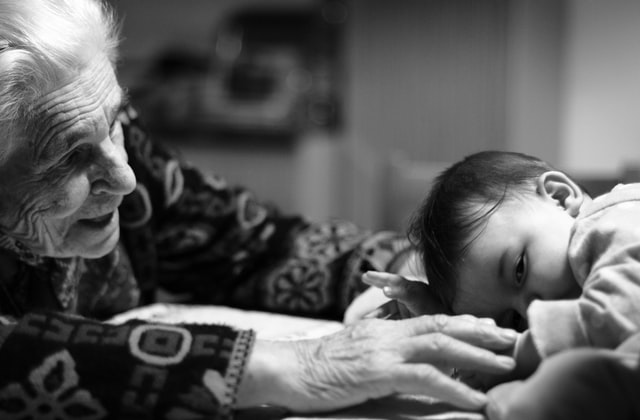Doll Therapy
As we have already talked about in our article about Dementia, it is not an illness, but a
frame that encompasses different symptoms that show mental deterioration.
In resume, some characteristics of its spectrum are that they last a lifetime, that they involve
cognitive impairment, and that they are progressive, that is, they get worse over time.
One important symptom that people with dementia experience often is distress. It can
show up in different behaviors, such as anger, depression, fear, and suspiciousness.
As said by nurses and researchers Gary Mitchell and Hugh O’ Donell (2013), distress
has been historically treated through pharmacological treatments with prescription drugs
as risperidone and olanzapine.
But in the last few decades, a more holistic approach to medicine is making its way.
Scientists are turning their heads towards therapies that do not involve the use of
prescription drugs. Broadening their interest in investigating treatments whose side
effects are minimal or nonexistent.
Non-pharmacological treatments are called “alternative therapies”.
Some of the most popular alternative therapies for treating dementia are:
- Music therapy
- Aromatherapy
- Art Therapy
- Reminiscence therapy
- Reality orientation therapy.
Doll therapy is also one of them. Its scientific research started twenty years ago, first
talking about stuffed animals. Papers on human baby dolls started coming out just about
fifteen years ago. It is a relatively new field that is already showing promising results.
What is Doll therapy based in?
Doll therapy is based on attachment theory.
Born in the psychology field, attachment theory assumes that the patient seeks to reunite or to be attached to a familiar figure to feel safe.
We can see it in children, who cling to their favorite teddy bear or any other “transitional” object, such as a blanket or a doll, to work as anchors of assurance that make challenging situations feel easier and smoother.
Doll therapy is commonly applied in children or teenagers for different reasons, but its popularity is just starting to grow amongst elders with dementia. Some of the benefits that research results demonstrate include:
• Dropped anxiety levels
• Decreased agitation
• A relevant increase in happiness levels
• Increased social interaction
• More disposition to activeness
• Improved ability to receive care
• Fewer negative verbal expressions
• Improved mood
• Decrease in wandering
• Decrease in obsessions
• Improved food intake
The therapy also offers some indirect benefits. These are the ones that don’t relate directly with the patient’s health but with the people around them and the whole society. Such as:
- Reduce the use of antipsychotic drugs
- Low cost
- Reduce caregiver’s stress
- Is a safe, low-risk type of therapy
But no therapy is completely perfect. Some people who are against it argue that doll therapy involves treating people with dementia as children and that that is demeaning.
About the method
Baby dolls are used in some facilities and memory-care units at senior living facilities. Doll therapy involves giving a person with dementia a doll to hold as if it were a baby. In therapy, Residents take care of it; they might rock the doll, feed it, change its clothes, brush it sing to it, and cuddle it.
With the dolls, residents essay the expression of needs, and it helps to maintain their communication skills. They make a strong connection with the doll and it later extends to other people, improving their interactions and preventing social withdrawal.
Baby dolls have a calming influence on some residents and reduce agitation in both men and women. They notoriously relieve stress and anxiety, as they feel comforted and reassured.
Even though there is not an established methodology for introducing doll therapy to a person with dementia, here are some considerations to have in mind:
- Do not tell the person that the doll is alive. But in case they think it is, do not start an argument or try to correct them. Some people perceive the doll as a doll, and some others ask if it is real. In this case, it is better to ask them: What do you want it to be?
- Do not force the doll to the person. The person should be able to decide if they like the doll or not. The caregiver might just leave the doll in the room, or present it to the person. They should decide if it is something they enjoy.
- Inform other caregivers about the doll’s purpose. Everyone around should be aware of what the doll means to the patient so it can be treated accordingly, and they can keep on with the therapy.
- Choose a doll that does not cry. It can be confusing or stressful for the patient.
Some of the negative results that people might experience during therapy are:
- Losing the doll.
- Feelings of fatigue or exhaustion from caring for the doll.
- The doll might detonate certain thoughts and unwanted behaviors such as the person thinking the doll is dead.
Therapy dolls are specially made to look like real babies, but if you are taking care of a person with dementia and want to try doll therapy, feel free to use any kind of doll, but preferably, chose one that does not cry.
Have in mind that all dementias are different as they are experienced by different people. For some, doll therapy might work, but for others, it won’t. The best way to find out is by trying it.
Therapy dolls are specially made to look like real babies, but if you are taking care of a person with dementia and want to try doll therapy, feel free to use any kind of doll, but preferably, chose one that does not cry.
Have in mind that all dementias are different as they are experienced by different people. For some, doll therapy might work, but for others, it won’t. The best way to find out is by trying it.
References
Mitchell, G. and O’Donell, H. (2013). The therapeutic use of doll therapy in dementia. British Journal of Nursing, 2013, Vol 22, No 6. https://www.researchgate.net/profile/Gary-Mitchell-2/publication/236863116_The_therapeutic_use_of_doll_therapy_in_dementia/links/0deec52010e9e0d149000000/The-therapeutic-use-of-doll-therapy-in-dementia.pdf
Edmonds, G. Dementia Careblazers (2018). Does doll therapy for dementia really work? https://www.youtube.com/watch?v=DdrikfkyHNI







